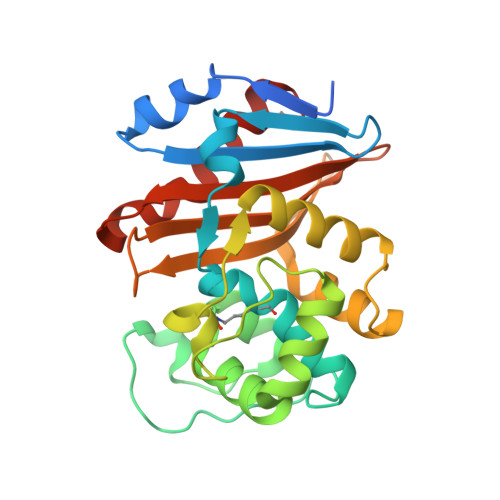An Ion-Pair Induced Intermediate Complex Captured in Class D Carbapenemase Reveals Chloride Ion as a Janus Effector Modulating Activity.
Zhou, Q., Catalan, P., Bell, H., Baumann, P., Cooke, R., Evans, R., Yang, J., Zhang, Z., Zappala, D., Zhang, Y., Blackburn, G.M., He, Y., Jin, Y.(2023) ACS Cent Sci 9: 2339-2349
- PubMed: 38161376
- DOI: https://doi.org/10.1021/acscentsci.3c00609
- Primary Citation of Related Structures:
8QNZ - PubMed Abstract:
Antibiotic-resistant Enterobacterales that produce oxacillinase (OXA)-48-like Class D β-lactamases are often linked to increased clinical mortality. Though the catalytic mechanism of OXA-48 is known, the molecular origin of its biphasic kinetics has been elusive. We here identify selective chloride binding rather than decarbamylation of the carbamylated lysine as the source of biphasic kinetics, utilizing isothermal titration calorimetry (ITC) to monitor the complete reaction course with the OXA-48 variant having a chemically stable N -acetyl lysine. Further structural investigation enables us to capture an unprecedented inactive acyl intermediate wedged in place by a halide ion paired with a conserved active site arginine. Supported by mutagenesis and mathematical simulation, we identify chloride as a "Janus effector" that operates by allosteric activation of the burst phase and by inhibition of the steady state in kinetic assays of β-lactams. We show that chloride-induced biphasic kinetics directly affects antibiotic efficacy and facilitates the differentiation of clinical isolates encoding Class D from Class A and B carbapenemases. As chloride is present in laboratory and clinical procedures, our discovery greatly expands the roles of chloride in modulating enzyme catalysis and highlights its potential impact on the pharmacokinetics and efficacy of antibiotics during in vivo treatment.
Organizational Affiliation:
Key Laboratory of Synthetic and Natural Functional Molecule, College of Chemistry and Materials Science, Northwest University, Xi'an 710127, P. R. China.


















